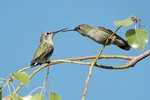Things You'll Need
Bowl/fruit basket
Tissue
Large box
Lamp/heating pad
Cat/dog food
Baby cereal
Hard-boiled egg yolks
Water
Dish
Fruit
Seeds
Cage
Perch/branches
Cedar waxwings are colorful songbirds native to the northern U.S. These are fruit-eating birds that travel in social flocks. If you find a cedar waxwing nest on your property, and believe that the babies are orphaned, give the parents at least three hours to return. If they don't, take steps to raise the babies yourself until they're old enough to be released.
Provide a new "nest" for the baby cedar waxwings. Use a bowl or berry basket, and fill it with wadded tissue. The tissue should fully support the bodies of the young birds; at their youngest stage, babies don't have the strength to sit up for themselves.
Put your nest inside another box to protect it from getting knocked around. Wrap a heating pad in a towel and put it inside the box, set on low, or place a lamp near the box to keep the baby birds warm.
Mix dog or cat food, baby cereal and hard-boiled egg yolks with warm water until they become soft. Scoop small amounts of this mixture into the baby birds' mouths when they open them. Never put liquid into the mouths of the baby birds. Feed them every 30 to 60 minutes during the day.
Put baby birds into a large wire cage once they get their feathers. Add branches and perches to the cage for flying practice. Put a water dish in the cage and fruit and seeds on the ground of the cage. As the babies learn to eat these for themselves, gradually wean them off the hand feedings.
Take the baby cedar waxwing birds outside to a tree or fence to release them once they're flying and eating for themselves.
Tips
Cedar waxwings are brown, gray and yellow with black masks.
Many baby birds leave their nests in as little as two weeks.
Warnings
Even with careful feeding and protection, baby cedar waxwings may die without their parents.





